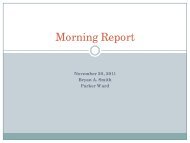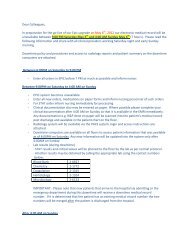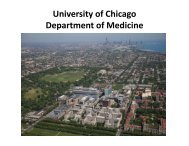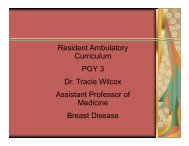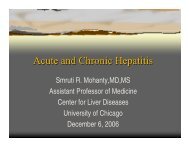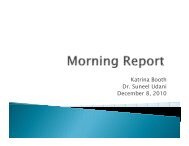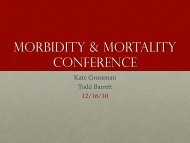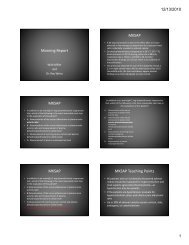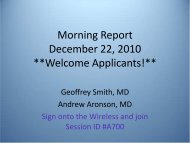Electrolytes and Acid Base with Suneel Udani 4.11.11
Electrolytes and Acid Base with Suneel Udani 4.11.11
Electrolytes and Acid Base with Suneel Udani 4.11.11
Create successful ePaper yourself
Turn your PDF publications into a flip-book with our unique Google optimized e-Paper software.
Electrolyte <strong>and</strong> <strong>Acid</strong> <strong>Acid</strong>-<strong>Base</strong> <strong>Base</strong><br />
Board B BBoard dR Review i<br />
<strong>Suneel</strong> M <strong>Udani</strong> MD MPH<br />
4/11/2011<br />
/ / 0
Question Question 1<br />
1<br />
A 64 64-year year-old old man comes for a routine physical examination.<br />
During the past year, his urine output has increased <strong>and</strong> he urinates<br />
approximately approximately pp y two to three times nightly. g y<br />
He does not have daytime urinary frequency, urinary hesitancy, or a<br />
decreased dec eased urinary a y stream. st ea . He also a so has as had ad increased c eased thirst t st <strong>and</strong> a d<br />
has been drinking more water than usual. His weight has been<br />
stable.<br />
He has bipolar disorder that was treated <strong>with</strong> lithium for 20 years;<br />
10 years ago, he was switched to divalproex sodium. His brother<br />
has sickle cell trait.
Physical Exam<br />
Afebrile<br />
BP 148/78 HR 78 RR 18 BMI 20<br />
The remainder of the physical<br />
examination is normal.<br />
On abdominal ultrasound, the right<br />
kidney is 8.6 cm <strong>and</strong> the left kidney<br />
i is 93 9.3 cm. There Th is i no<br />
hydronephrosis<br />
Question Question 1 1 (cont)<br />
(cont)<br />
146 107 34<br />
3.6 26 2.1<br />
Question Question 1 1 (cont)<br />
(cont)<br />
Which of of the the following following is the most most likely<br />
likely<br />
diagnosis?<br />
A) Diabetic nephropathy<br />
B) Lithium-induced nephrotoxicity<br />
C) Obstructive uropathy<br />
D) ) Sickle cell nephropathy p p y
Question Question 1 1 (cont)<br />
(cont)<br />
Which of the following is the most likely<br />
diagnosis?<br />
A) Diabetic nephropathy<br />
B) Lithium-induced nephrotoxicity<br />
C) Obstructive uropathy<br />
D) ) Sickle cell nephropathy p p y
Hypernatremia<br />
Hypernatremia must always result from a defect in<br />
sensation of thirst or access to water<br />
Categorization of hypernatremia depends on<br />
ADH ADH-renal l response to a state of f hyper- h<br />
osmolality
Na > 145 mmol/L<br />
Clinical Approach to<br />
Urine Osm<<br />
700 mOsm/L<br />
Urine Osm><br />
700 mOsm/L<br />
Hypernatremia<br />
Give<br />
DDAVP 4<br />
mcg IV X 1<br />
Renal loss of H20 inadequate + water<br />
intake<br />
Extra-renal H 20 loss, inadequate water<br />
intake + osmotic diuresis (glucose,<br />
mannitol)<br />
Renal<br />
function<br />
normal or<br />
near normal<br />
Renal<br />
function<br />
severely<br />
abnormal<br />
b l<br />
Urine<br />
osmolality<br />
unchanged<br />
Urine osmolality<br />
corrects to > 1000<br />
msOsm<br />
Nephrogenic DI<br />
Central DI<br />
Renal Tubular Damage<br />
(impaired H 20 h<strong>and</strong>ling)
Physical Exam<br />
Afebrile<br />
BP 148/78 HR 78 RR 18 BMI 20<br />
The remainder of the physical<br />
examination is normal.<br />
On abdominal ultrasound, the right<br />
kidney is 8.6 cm <strong>and</strong> the left kidney<br />
i is 93 9.3 cm. There Th is i no<br />
hydronephrosis<br />
Question Question 1 1 (cont)<br />
(cont)<br />
146 107 34<br />
3.6 26 2.1<br />
Question Question 2<br />
2<br />
A A32 A32-year A 32 year-old year old man man is brought to to the the emergency<br />
emergency<br />
department after becoming disoriented,<br />
combative combative, <strong>and</strong> <strong>and</strong> agitated agitated earlier earlier that that day. day<br />
H He i is accompanied i d b by a f friend, i d who h states that h<br />
the patient has a history of alcohol <strong>and</strong> drug<br />
abuse, b i including l di i inhalants.<br />
h l
Physical Exam<br />
Exam<br />
Uncooperative <strong>and</strong><br />
slightly g y disoriented.<br />
Question 2 2 (cont)<br />
(cont)<br />
142 109 18<br />
4.1 23 1.1<br />
Question 2 2 (cont)<br />
(cont)<br />
Which of of the the following following is the most most likely<br />
likely<br />
diagnosis?<br />
A) Alcoholic ketoacidosis<br />
B) Diabetic ketoacidosis<br />
C) Ethylene glycol ingestions<br />
D) ) Isopropyl p py alcohol ingestion g<br />
E) Toluene ingestion
Question 2 2 (cont)<br />
(cont)<br />
Which of of the the following following is the most most likely<br />
likely<br />
diagnosis?<br />
A) Alcoholic ketoacidosis<br />
B) Diabetic ketoacidosis<br />
C) Ethylene glycol ingestions<br />
D) ) Isopropyl p py alcohol ingestion g<br />
E) Toluene ingestion
Alcoholic<br />
Ketoacidosis<br />
Diabetic<br />
Ketoacidosis<br />
Ethylene Glycol<br />
ingestion<br />
Isopropyl p py Alcohol<br />
ingestion<br />
Toluene ingestion<br />
Question Question 2<br />
2<br />
Osmolal Gap Metabolic <strong>Acid</strong>osis Elevated Anion Gap
Alcoholic<br />
Ketoacidosis<br />
Question Question 2<br />
2<br />
Osmolal Gap Metabolic <strong>Acid</strong>osis Elevated Anion Gap<br />
Normal<br />
(must correct for<br />
ETOH in calculated<br />
osmoles)<br />
Diabetic Normal<br />
Ketoacidosis<br />
Ethylene Glycol<br />
↑↑<br />
ingestion g (> 10 mosm/kg)<br />
Isopropyl Alcohol<br />
ingestion<br />
↑↑<br />
(> 10 mosm/kg)<br />
Toluene ingestion Normal
Alcoholic<br />
Normal<br />
Ketoacidosis (must correct for<br />
ETOH in calculated<br />
osmoles)<br />
Diabetic Normal<br />
Ketoacidosis<br />
Ethylene Glycol<br />
↑↑<br />
ingestion g (> 10 mosm/kg)<br />
Isopropyl Alcohol<br />
ingestion<br />
Question Question 2<br />
2<br />
Osmolal Gap Metabolic <strong>Acid</strong>osis Elevated Anion Gap<br />
↑↑<br />
(> 10 mosm/kg)<br />
Toluene ingestion Normal<br />
+<br />
++<br />
++<br />
--<br />
++
Alcoholic<br />
Normal<br />
Ketoacidosis (must correct for<br />
ETOH in calculated<br />
osmoles)<br />
Diabetic Normal<br />
Question Question 2<br />
2<br />
Osmolal Gap Metabolic <strong>Acid</strong>osis Elevated Anion Gap<br />
+ +<br />
Ketoacidosis ++ ++<br />
Ethylene Glycol<br />
↑↑<br />
ingestion g (> 10 mosm/kg)<br />
Isopropyl Alcohol<br />
ingestion<br />
↑↑<br />
(> 10 mosm/kg)<br />
Toluene ingestion Normal<br />
++ ++<br />
-- --<br />
++ --
Question 2
Physical Exam<br />
Exam<br />
Uncooperative <strong>and</strong><br />
slightly g y disoriented.<br />
Question 2 2 (cont)<br />
(cont)<br />
142 109 18<br />
4.1 23 1.1<br />
Question Question 3<br />
3<br />
65 y/o gentleman evaluated for 135 105 22<br />
3-month history of progressive<br />
malaise, fatigue, weakness.<br />
He has 10-year history of<br />
hypertension.<br />
Meds<br />
HCTZ<br />
Atenolol<br />
Exam WNL<br />
3.0 18 1.8<br />
> 8.5 8 5 < < 340<br />
340<br />
7.33/28/102
Question Question 3<br />
3<br />
Which of of the the following following is the most most likely<br />
likely<br />
diagnosis?<br />
A. Diabetic nephropathy<br />
B. Distal (type I) renal tubular acidosis<br />
C. Hypertensive yp nephrosclerosis<br />
p<br />
D. Proximal (type 2) renal tubular acidosis
Question Question 3<br />
3<br />
Which of of the the following following is the most most likely<br />
likely<br />
diagnosis?<br />
A. Diabetic nephropathy<br />
B. Distal (type I) renal tubular acidosis<br />
C. Hypertensive yp nephrosclerosis<br />
p<br />
D. D. Proximal Proximal (type (type 2) 2) renal renal tubular tubular acidosis acidosis
Renal Tubular Tubular <strong>Acid</strong>osis<br />
How How does does the the kidney kidney maintain maintain acid acid-base base base balance?<br />
balance?<br />
1. R Reclaim l i filtered fil d bicarbonate bi b<br />
Proximal (type II) RTA<br />
2. Distal acidification<br />
Distal (type I) RTA<br />
Type yp<br />
IV RTA
Renal Tubular Tubular <strong>Acid</strong>osis<br />
Reclamation of Filtered<br />
HCO -<br />
3<br />
Requires luminal luminal carbonic<br />
carbonic<br />
anhydrase<br />
P Proximal i l RTA RTA manifests if<br />
<strong>with</strong> other proximal tubule<br />
wasting<br />
Hypokalemia<br />
Hypophosphatemia<br />
Bicarbonaturia
Distal <strong>Acid</strong>ification<br />
Renal Tubular Tubular <strong>Acid</strong>osis<br />
Alpha Alpha-intercalated intercalated cell<br />
<strong>Acid</strong> Aid <strong>Acid</strong> secretion ti requires i buffering bff i<br />
<strong>Acid</strong> excreted as titratable acid<br />
<strong>Acid</strong> excreted as Ammonium<br />
(NH + (NH +<br />
4 )<br />
Type I (traditional “Distal RTA”)<br />
hypokalemic hypokalemic <strong>and</strong> severe acidosis<br />
Type IV IV—”Hyperkalemic ”Hyperkalemic RTA”
Diagnosis of of RTA<br />
RTA<br />
Assessment of bicarbonaturia, ,p proximal tubular wasting g<br />
<strong>and</strong>/or distal acidification<br />
Urine pH<br />
Fractional excretion of Bicarbonate, phosphorus <strong>and</strong><br />
TTKG<br />
Urinary y Anion Gap p ([Na] ([ ] urine urine urine urine + [K] [ ] urine urine) urine urine) – [Cl] [ ] urine<br />
In setting of acidosis [Cl] urine > ([Na] urine + [K] urine<br />
Indirect measurement of urine NH +<br />
4<br />
urine)
Clues to to proximal proximal vs vs distal distal RTA<br />
RTA<br />
Proximal (type (yp II) )<br />
Distal (type (yp I) )<br />
Concomitant proximal<br />
tubular bl d dysfunction f i (i.e. (i<br />
Fanconi’s syndrome)<br />
Very high bicarbonate<br />
requirements<br />
Urine pH low in steady<br />
state<br />
Severe hypokalemia<br />
Urine pH not maximally<br />
acidified<br />
History y of recurrent<br />
stones, bone disease
Question Question 3<br />
3<br />
65 y/o gentleman evaluated for 135 105 22<br />
3-month history of progressive<br />
malaise, fatigue, weakness.<br />
He has 10-year history of<br />
hypertension.<br />
Meds<br />
HCTZ<br />
Atenolol<br />
Exam WNL<br />
3.0 18 1.8<br />
> 8.5 8 5 < < 340<br />
340<br />
7.33/28/102
Question Question 4<br />
4<br />
A 44 44-year year-old y old man is evaluated in the hospital p because<br />
of disorientation <strong>and</strong> hallucinations.<br />
He was admitted to the hospital 4 days ago for a<br />
subarachnoid hemorrhage that was repaired <strong>with</strong><br />
surgical clipping clipping.<br />
His medical medical history is is otherwise otherwise unremarkable; unremarkable; before<br />
before<br />
he was admitted to the hospital, he took no<br />
medications.
Physical Exam<br />
He is disoriented, confused,<br />
<strong>and</strong> hallucinating.<br />
Temperature p is normal<br />
Lying BP 140/80 HR 90 RR<br />
16<br />
St<strong>and</strong>ing Sta d g BP 120/60 0/60 HR H 110 0<br />
The remainder of the<br />
physical examination is<br />
normal.<br />
Laboratory values were<br />
normal on admission<br />
Question Question 4<br />
4<br />
118 85<br />
4.1 23<br />
POsm 248 mosm/kg<br />
Urine Na 105 K 20 Cl 90<br />
Ui UrineOsm O 633 mosm/kg /k
Question Question 4<br />
4<br />
Which of of the the following following is the most most likely<br />
likely<br />
diagnosis?<br />
A. Adrenal insufficiency<br />
B. Cerebral Salt Wasting<br />
C. Hypothyroidism<br />
yp y<br />
D. SIADH
Question Question 4<br />
4<br />
Which of of the the following following is the most most likely<br />
likely<br />
diagnosis?<br />
A. Adrenal insufficiency<br />
B. B. Cerebral Cerebral Salt Salt Wasting Wasting<br />
C. Hypothyroidism<br />
yp y<br />
D. SIADH
Na AND H 2O<br />
deficit<br />
Hypovolemia<br />
Total body Na ↓↓<br />
Total body H 2O ↓<br />
EABV ↓<br />
RAAS ↑↑<br />
ADH ↑<br />
**Urine Na < 20<br />
meq/L<br />
Urine Osm > 300<br />
mOsm/L<br />
Clinical Approach to<br />
Hyponatremia<br />
H2O excess<br />
ONLY<br />
**“Look” the same to the body<br />
“Look” the same to the body<br />
(urine findings dependent on intact<br />
(urine findings dependent on intact<br />
tubular b l function f i <strong>and</strong> dabsence b of f<br />
tubular function<br />
Euvolemia<br />
<strong>and</strong> absence of diuretics)<br />
diuretics)<br />
Total body Na nl<br />
Total body H2O ↑↑<br />
EABV nl (or ( high) g )<br />
RAAS (-)<br />
ADH ↑<br />
Urine Na > 40<br />
meq/L<br />
Urine Osm > 300<br />
RAAS (-)<br />
ADH ↓<br />
Urine Na < 10<br />
meq/L<br />
Urine Osm < 100<br />
mOsm/L mOsm/L<br />
Na AND H 2O<br />
excess<br />
Hypervolemia<br />
Total body Na ↑<br />
Total body H 2O ↑↑<br />
EABV ↓<br />
RAAS ↑↑<br />
ADH ↑<br />
**Urine Na < 20<br />
meq/L<br />
Urine Osm > 300<br />
mOsm/L
Urine Na<br />
Urine Osmolality<br />
Blood Pressure<br />
Central venous<br />
pressure p<br />
CSW vs. SIADH<br />
SIADH Cerebral Salt Wasting
CSW vs. SIADH<br />
SIADH Cerebral Salt Wasting<br />
Urine Na ↑↑ ↑↑<br />
Urine Osmolality ↑↑ ↑↑<br />
Blood Pressure<br />
Central venous<br />
pressure p
CSW vs. SIADH<br />
SIADH Cerebral Salt Wasting<br />
Urine Na ↑↑ ↑↑<br />
Urine Osmolality ↑↑ ↑↑<br />
Blood Pressure Normal<br />
Central venous<br />
pressure p<br />
Ø orthostatic th t ti change h<br />
Normal High Low<br />
++ orthostatic change
Physical Exam<br />
He is disoriented, confused,<br />
<strong>and</strong> hallucinating.<br />
Temperature p is normal<br />
Lying BP 140/80 HR 90 RR<br />
16<br />
St<strong>and</strong>ing Sta d g BP 120/60 0/60 HR H 110 0<br />
The remainder of the<br />
physical examination is<br />
normal.<br />
Laboratory values were<br />
normal on admission<br />
Question Question 4<br />
4<br />
118 85<br />
4.1 23<br />
POsm 248 mosm/kg<br />
Urine Na 105 K 20 Cl 90<br />
Ui UrineOsm O 633 mosm/kg /k
Question Question 5<br />
5<br />
A A19 A19-year A 19 year-old year old man man is evaluated in in the the emergency<br />
emergency<br />
department for altered mental status.<br />
He is accompanied by a friend, who states that<br />
the patient patient was was asymptomatic asymptomatic 12 12 hours hours ago.<br />
ago.<br />
Medical history history is is noncontributory, noncontributory <strong>and</strong> <strong>and</strong> he he takes<br />
takes<br />
no medications. He does not drink alcoholic<br />
beverages or or use use illicit illicit drugs.<br />
drugs.
Physical Exam<br />
Patient is comatose<br />
Afebrile, BP 90/60 HR 110<br />
RR 28<br />
Cardiopulmonary<br />
examination is normal.<br />
Arterial te a oxygen o yge saturation sat at o is s<br />
96% by pulse oximetry <strong>with</strong><br />
the patient breathing ambient<br />
air.<br />
There are no localized<br />
findings on neurologic<br />
examination.<br />
Question Question 5<br />
5<br />
142 108 14<br />
3.6 14<br />
POsm 290 mosm/kg<br />
UA UA: + k ketones t ( (-- ( --) ) glucose l<br />
7.42/20/94
Question 5<br />
5<br />
Which of of the the following following is the most most likely<br />
likely<br />
diagnosis?<br />
A. Alcoholic ketoacidosis<br />
B. Ethylene glycol intoxication<br />
C. Methanol intoxication<br />
D. Salicylate toxicity
Question 5<br />
5<br />
Which of of the the following following is the most most likely<br />
likely<br />
diagnosis?<br />
A. Alcoholic ketoacidosis<br />
B. Ethylene glycol intoxication<br />
C. Methanol intoxication<br />
D. D. Salicylate Salicylate toxicity toxicity
Approach to the Patient <strong>with</strong> <strong>Acid</strong>-<br />
HCO 3 - < 24 <br />
Metabolic<br />
<strong>Acid</strong>osis<br />
pH <<br />
735A 7.35<strong>Acid</strong>emia id i<br />
<strong>Base</strong> Disorders<br />
HCO 3 - > 24 +<br />
pCO 2 > 45 <br />
Respiratory<br />
<strong>Acid</strong>osis<br />
Estimate pH<br />
(ABG)<br />
HCO 3 - > 30 <br />
Metabolic<br />
Alkalosis<br />
pH p > 7.45<br />
Alkalemia<br />
HCO 3 - < 30 +<br />
pCO 2 < 35 <br />
Respiratory<br />
Alkalosis
Assess for for Compensation<br />
Compensation<br />
Acute resp p acidosis Acute resp p alkalosis<br />
The [HCO [HCO3] ] will increase by 1<br />
mmol/l for every 10 mmHg<br />
elevation in pCO pCO2 above 40<br />
mmHg mmHg.<br />
Expected [HCO [HCO3] ] = 24 + {<br />
(Actual pCO pCO2 - 40) / 10 }<br />
Chronic Chronic resp resp acidosis<br />
acidosis<br />
The [HCO3] will increase by 4<br />
mmol/l for every 10 mmHg<br />
elevation in pCO2 p above<br />
40mmHg.<br />
Expected [HCO3] = 24 + 4 {<br />
(Actual pCO2 - 40) / 10}<br />
The [HCO3] will decrease by<br />
2 mmol/l for every 10 mmHg<br />
decrease in pCO2 below 40<br />
mmHg mmHg.<br />
Expected [HCO3] = 24 -2 2 { (<br />
40 - Actual pCO2) / 10 }<br />
Chronic Chronic resp resp alkalosis<br />
alkalosis<br />
The [HCO3] will decrease by<br />
5 mmol/l for every 10 mmHg<br />
decrease in pCO2 p below 40<br />
mmHg.<br />
Expected [HCO3] = 24 -5 5 { (<br />
40 - Actual pCO2 ) / 10 }<br />
(range: +/ +/- +/ 2)
Assess for for Compensation<br />
Compensation
Physical Exam<br />
Patient is comatose<br />
Afebrile, BP 90/60 HR 110<br />
RR 28<br />
Cardiopulmonary<br />
examination is normal.<br />
Arterial te a oxygen o yge saturation sat at o is s<br />
96% by pulse oximetry <strong>with</strong><br />
the patient breathing ambient<br />
air.<br />
There are no localized<br />
findings on neurologic<br />
examination.<br />
Question Question 5<br />
5<br />
142 108 14<br />
3.6 14<br />
POsm 290 mosm/kg<br />
UA UA: + k ketones t ( (-- ( --) ) glucose l<br />
7.42/20/94
Question Question 6<br />
6<br />
A A22 A22-year A 22 year-old year old old woman woman is is evaluated evaluated at at an an on on-site site medical<br />
medical<br />
center after collapsing while running a marathon.<br />
She is disoriented. During the evaluation, she<br />
experiences p a g generalized tonic tonic-clonic clonic seizure lasting g 3<br />
minutes.<br />
A wristb<strong>and</strong> indicates that she has diabetes mellitus.
Physical Exam<br />
Exam<br />
Temp normal<br />
BP BP 120/60 120/60 HR HR 100 100 RR RR 28<br />
28<br />
Question Question 7<br />
7<br />
There is no evidence of hypovolemia or edema.<br />
Cardiopulmonary examination is normal.<br />
On neurologic examination, she is confused but has no<br />
evidence of a focal neurologic g deficit.<br />
Na 118 118 meq/L meq/L Glucose Glucose 120 120 mg/dl<br />
mg/dl
Question Question 7<br />
7<br />
Which of of the the following following is the most appropriate<br />
appropriate<br />
next step in management?<br />
A. 3% saline infusion<br />
B. 50% glucose bolus infusion<br />
C. IV Furosemide infusion<br />
D. IV 0.9% saline infusion
Question Question 7<br />
7<br />
Which of of the the following following is the most appropriate<br />
appropriate<br />
next step in management?<br />
A. A. 3% 3% saline saline infusion infusion<br />
B. 50% glucose bolus infusion<br />
C. IV Furosemide infusion<br />
D. IV 0.9% saline infusion
Treatment of hyponatremia:<br />
Special circumstances<br />
Acute hyponatremia <strong>with</strong> neurologic dysfunction<br />
must be treated emergently<br />
3% Saline solution 100 ml administered over 15<br />
minutes (can be repeated up to 3 times)<br />
Raise [Na] by approx 5 mmol/L<br />
Slow correction to st<strong>and</strong>ard goal
Question Question 8<br />
8<br />
56 56-year year y old man <strong>with</strong> a history y of alcoholism is found<br />
lying on the street.<br />
O On arrival i l at tth the emergency department, d t t he h is i<br />
confused.<br />
Physical Exam<br />
T 36.1 °C C BP 126/80 HR 70<br />
Funduscopic examination shows no papilledema.<br />
Cardiac, pulmonary, <strong>and</strong> abdominal examinations are<br />
normal normal.
138 98 45<br />
54 14 28
Question Question 8<br />
8<br />
What is the most most likely likely diagnosis?<br />
diagnosis?<br />
A. Al Alcoholic h li k ketoacidosis id i<br />
B. Diabetic ketoacidosis<br />
C. Ethylene glycol poisoining<br />
D D. Lactic acidosis<br />
acidosis
Question Question 8<br />
8<br />
What is the most most likely likely diagnosis?<br />
diagnosis?<br />
A. Al Alcoholic h li k ketoacidosis id i<br />
B. Diabetic ketoacidosis<br />
C. Ethylene glycol poisoning<br />
D D. Lactic acidosis<br />
acidosis
Question 8
138 98 45<br />
54 14 28
Question Question 9<br />
9<br />
A A47 A47-year A 47 year-old year old man <strong>with</strong> a long long-st<strong>and</strong>ing long st<strong>and</strong>ing history of<br />
alcoholism is hospitalized for abdominal pain, nausea,<br />
<strong>and</strong> vomiting of 7 days’ duration.<br />
His last drink was 6 days y ago. g<br />
He has lost approximately pp y 10% of his body y weight g over<br />
the past 4 months; he states that his weight loss was<br />
caused by drinking alcohol <strong>and</strong> not eating.
Physical y Exam<br />
He appears cachectic.<br />
T 37.1 BP 100/70 HR 110 rr<br />
18 BMI 17<br />
He is not confused or<br />
tremulous tremulous.<br />
There is midepigastric<br />
tenderness <strong>with</strong>out rebound.<br />
Bowel sounds are present.<br />
Neurologic examination is<br />
normal.<br />
Question Question 9<br />
9<br />
130 90<br />
3.4 20<br />
Ca 9.0 mg/dl Phos 3.5 mg/dl<br />
Amylase 300 IU/L /<br />
Lipase 150 IU/L<br />
UA UA—ketones ketones positive
Question Question 9<br />
9<br />
The patient p receives immediate thiamine replacement, p folic acid<br />
supplementation, <strong>and</strong> a multivitamin followed by vigorous<br />
intravenous fluid replacement <strong>with</strong> 5% dextrose <strong>and</strong> normal<br />
saline <strong>with</strong> aggressive gg potassium p replacement. p<br />
Morphine is used to control pain.<br />
Eighteen hours later, the patient’s abdominal pain has improved<br />
but he becomes restless, agitated, g <strong>and</strong> extremely weak <strong>and</strong> is<br />
barely able to raise his extremities against gravity.
Question Question 9<br />
9<br />
Which is is the the most most likely likely cause cause of of the the patient patient’s s new<br />
new<br />
findings?<br />
A. Hypercalcemia<br />
B. Hypokalemia<br />
C. Hyponatremia<br />
yp<br />
D. Hypophosphatemia
Question Question 9<br />
9<br />
Which is is the the most most likely likely cause cause of of the the patient patient’s s new<br />
new<br />
findings?<br />
A. Hypercalcemia<br />
B. Hypokalemia<br />
C. Hyponatremia<br />
yp<br />
D. D. Hypophosphatemia<br />
Hypophosphatemia
Symptoms of Hypophosphatemia<br />
Myopathy y p yRhabdomyolysis y y<br />
Hemolysis<br />
Respiratory failure<br />
↓Myocardial performance<br />
Leukocyte dysfunction<br />
Neurologic dysfunction
Phos < 2.5 mg/dl<br />
Approach to the patient <strong>with</strong><br />
Urine Phos <<br />
100 mg/d or<br />
FePi < 5%<br />
Hypophosphatemia PTH<br />
Urine Phos ><br />
100 mg/d or<br />
FePi > 5%<br />
Recent glucose<br />
<strong>and</strong>/or insulin<br />
administration<br />
No Recent<br />
glucose <strong>and</strong>/or<br />
insulin<br />
administration<br />
Renal Phosphate wasting<br />
2º to<br />
Hyperparathyroidism,<br />
Intracellular<br />
redistribution<br />
Hi Highh<br />
Severe total body<br />
deficiency<br />
Hyperparathyroidism<br />
yp p y<br />
PTH<br />
normal Fanconi’s Fanconi s, TIO TIO, XLH XLH,<br />
ADHR
Question Question 9<br />
9<br />
The patient p receives immediate thiamine replacement, p folic acid<br />
supplementation, <strong>and</strong> a multivitamin followed by vigorous<br />
intravenous fluid replacement <strong>with</strong> 5% dextrose <strong>and</strong> normal<br />
saline <strong>with</strong> aggressive gg potassium p replacement. p<br />
Morphine is used to control pain.<br />
Eighteen hours later, the patient’s abdominal pain has improved<br />
but he becomes restless, agitated, g <strong>and</strong> extremely weak <strong>and</strong> is<br />
barely able to raise his extremities against gravity.
Question 10<br />
A 45-year-old y black woman is evaluated for a 2-month history y of<br />
fatigue, nonproductive cough, decreased appetite, intermittent<br />
fever, right upper-quadrant abdominal pain, <strong>and</strong> a 4.5-kg (10.0lb)<br />
) weight g loss.<br />
Phys Exam 37.8 °C BP 104/68 mm Hg, HR 100/min RR 16<br />
BMI 28. 28 There are several erythematous 5- 5 to 10-mm 10 mm<br />
maculopapular lesions on the forehead.<br />
Cardiopulmonary examination is normal. Abdominal<br />
examination reveals hepatomegaly. There is bilateral inguinal<br />
lymphadenopathy. y p p y<br />
There is no edema.
Question Question 10<br />
10<br />
Laboratory studies<br />
Ca 11.2 mg/dl<br />
Tuberculin skin testing is negative.<br />
Phos 4.0 mg/dl<br />
Albumin 4.0 g/dl<br />
Urine culture is negative.<br />
Cr. 2.0 mg/dl<br />
Hgb g 12.2<br />
Chest radiograph shows bilateral<br />
hilar lymphadenopathy.<br />
Renal U/S Right kidney is 13.7 cm<br />
UA: 1+ prot 20 WBCS/hpf, WBC<br />
casts<br />
Urine Prot:Cr 0.914 mg/mg<br />
Left kidney is 15.4 cm. There is no<br />
hydronephrosis, <strong>and</strong> no kidney<br />
calculi are are seen<br />
seen
Question 10<br />
Which of of the the following following is the most most likely<br />
likely<br />
diagnosis?<br />
A. Amyloidosis<br />
B. Sarcoidosis<br />
C. Sjogren’s j g syndrome y<br />
D. SLE
Question 10<br />
Which of of the the following following is the most most likely<br />
likely<br />
diagnosis?<br />
A. Amyloidosis<br />
B. B. Sarcoidosis Sarcoidosis<br />
C. Sjogren’s j g syndrome y<br />
D. SLE
Overview of Calcium homeostasis
Calcium > 10.5<br />
mg/dl g<br />
Approach to the patient <strong>with</strong><br />
PTH<br />
appropriately<br />
suppressed<br />
PTH Above<br />
UNL<br />
Hypercalcemia<br />
PTHRP elevated<br />
PTHRP not<br />
detected<br />
Primary<br />
Hyperparathyroidism<br />
Humoral hypercalcemia<br />
or malignancy<br />
1, 25-OH<br />
vitamin D<br />
elevated<br />
1,25-OH<br />
vitamin D<br />
normal<br />
Granulomatous<br />
disease or<br />
lymphoma<br />
Lytic lesions of<br />
bone,<br />
immobilization
Question Question 10<br />
10<br />
Laboratory studies<br />
Ca 11.2 mg/dl<br />
Tuberculin skin testing is negative.<br />
Phos 4.0 mg/dl<br />
Albumin 4.0 g/dl<br />
Urine culture is negative.<br />
Cr. 2.0 mg/dl<br />
Hgb g 12.2<br />
Chest radiograph shows bilateral<br />
hilar lymphadenopathy.<br />
Renal U/S Right kidney is 13.7 cm<br />
UA: 1+ prot 20 WBCS/hpf, WBC<br />
casts<br />
Urine Prot:Cr 0.914 mg/mg<br />
Left kidney is 15.4 cm. There is no<br />
hydronephrosis, <strong>and</strong> no kidney<br />
calculi are are seen<br />
seen



